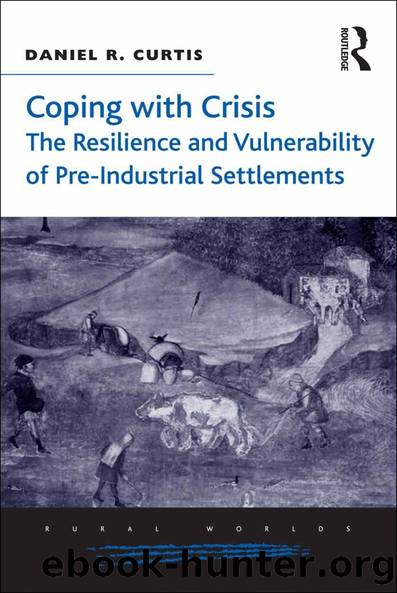Coping with Crisis: The Resilience and Vulnerability of Pre-Industrial Settlements by Daniel R. Curtis

Author:Daniel R. Curtis [Curtis, Daniel R.]
Language: eng
Format: epub
Tags: History, Europe, Medieval, Modern, 17th Century
ISBN: 9781317159636
Google: ziIpDAAAQBAJ
Publisher: Routledge
Published: 2016-05-13T16:15:24+00:00
Figure 6.1 Location of the Oldambt in the Northern Low Countries, c.1700
In the first section, the long-term context for the development of settlement in the Oldambt is laid out with an emphasis on the disastrous flooding of the late fifteenth and early sixteenth centuries, the shifting of villages, and the initial reclamation of the marshes which brings us up to the beginning of the eighteenth century. In the second section, the exceptional demographic growth and settlement expansion is shown for the period 1730â1900 (after the crises of the mid-seventeenth century through plague and flooding). Rural settlement in the Oldambt during these centuries was not just resilient but actually responded favourably to the same pressures (i.e. intense land consolidation) which drove many other pre-industrial societies to stagnation and contraction. In the third section, it is shown that this was connected to very particular modes of exploitation. It is clear that in the Oldambt there emerged a group of very successful tenant farmers (exploiting a long-term hereditary lease known as beklemrecht), who invested significant amounts of capital in modernised and commercialised grain farms on newly reclaimed fertile polders. However, this development did not destroy the rural communities. Newly proletarianised rural inhabitants instead developed an alternative economy distinct from that of the farmers. The facets of this âdual economyâ were wage labour on the large farms, intensive production of vegetables on micro-plots, the development of proto-industry and reliance on an initially well-functioning welfare system â all operating in the more general context of a stagnating urban economy (and therefore no âurban pull) of Groningen. In the fourth section, it is shown that the inequitable and dynamic constellations in property, social distribution of property, and power were significant in leading to the emergence of capital-intensive and commercialised farms on the polders â yet this does not explain the resilience and growth of the communities of agricultural labourers in the Oldambt during the eighteenth and nineteenth centuries. In the fifth section, it is suggested that this âdual economyâ of the agricultural labourers which emerged alongside the commercialised farm economy was responsible for the resilience, and may have had its origins in the distinctive identity already forged many centuries previously as a region of autonomous and egalitarian free farmers. In the final section these findings are placed into the wider theoretical framework described in Chapter 2 and one of the major problems of the theoretical framework is highlighted (and addressed again in Chapter 8).
Download
This site does not store any files on its server. We only index and link to content provided by other sites. Please contact the content providers to delete copyright contents if any and email us, we'll remove relevant links or contents immediately.
| Belgium | France |
| Germany | Great Britain |
| Greenland | Italy |
| Netherlands | Romania |
| Scandinavia |
Room 212 by Kate Stewart(5041)
The Crown by Robert Lacey(4731)
Endurance: Shackleton's Incredible Voyage by Alfred Lansing(4683)
The Iron Duke by The Iron Duke(4294)
The Rape of Nanking by Iris Chang(4140)
Joan of Arc by Mary Gordon(4022)
Killing England by Bill O'Reilly(3953)
Say Nothing by Patrick Radden Keefe(3904)
I'll Give You the Sun by Jandy Nelson(3362)
Shadow of Night by Deborah Harkness(3308)
Hitler's Monsters by Eric Kurlander(3270)
Mary, Queen of Scots, and the Murder of Lord Darnley by Alison Weir(3152)
Blood and Sand by Alex Von Tunzelmann(3140)
Darkest Hour by Anthony McCarten(3072)
Eleanor & Park by Rainbow Rowell(3063)
Margaret Thatcher: The Autobiography by Thatcher Margaret(3031)
Red Famine: Stalin's War on Ukraine by Anne Applebaum(2874)
Book of Life by Deborah Harkness(2869)
The One Memory of Flora Banks by Emily Barr(2804)
